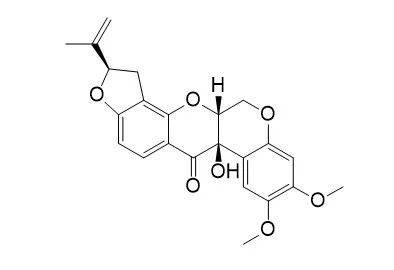| In vitro: |
| Chemosphere . 2022 Feb;288(Pt 2):132478. | | Field and laboratory characterization of rotenone attenuation in eight lakes of the Kenai Peninsula, Alaska[Pubmed: 34626650] | | Rotenone is a pesticide commonly used to eradicate Northern Pike (Esox lucius), an invasive species, in Southcentral Alaska. The present work incorporates a field investigation of rotenone attenuation in eight lakes of the Kenai Peninsula, following a CFT Legumine® treatment in October 2018 and a laboratory simulation to determine persistence under light/dark and sterile/nonsterile conditions representative of Southcentral Alaskan winters. In the field, rotenone degraded within <60 days of application in all lakes, while rotenolone, the primary product of rotenone degradation, persisted for up to <280 days post-treatment at two locations. Prolonged rotenolone attenuation was most likely caused by short days and ice cover between October and April. This hypothesis was supported by a laboratory simulation which revealed photolysis as the dominant process driving the overall degradation of rotenone and that microbial degradation will significantly contribute in the absence of sunlight under simulated "winter" conditions of 4 °C. Degradation model fit comparisons (pseudo-first order, multi-parameter linear, and gamma) indicate the most accurate prediction occurred when modeling all eight lakes grouped together in a single dataset, combined and treated with pseudo-first order model kinetics, based on Akaike information criteria (AIC) scores. | | Environ Toxicol Chem . 2012 May;31(5):1032-1041. | | Rotenone formulation fate in Lake Davis following the 2007 treatment[Pubmed: 22407799] | | In September 2007, Lake Davis (near Portola, California) was treated by the California Department of Fish and Game with CFT Legumine, a rotenone formulation, to eradicate the invasive northern pike (Esox lucius). The objective of this report is to describe the fate of the five major formulation constituents-rotenone, rotenolone, methyl pyrrolidone (MP), diethylene glycol monethyl ether (DEGEE), and Fennedefo 99-in water, sediment, and brown bullhead catfish (Ameiurus nebulosus; a rotenone-resistant species) by determination of their half-lives (t(1/2)) and pseudo first-order dissipation rate constants (k). The respective t(1/2) values in water for rotenone, rotenolone, MP, DEGEE, and Fennedefo 99 were 5.6, 11.1, 4.6, 7.7, and 13.5 d; in sediments they were 31.1, 31.8, 10.0, not able to calculate, and 48.5 d; and in tissues were 6.1, 12.7, 3.7, 3.2, and 10.4 d, respectively. Components possessing low water solubility values (rotenone and rotenolone) persisted longer in sediments (not detectable after 157 d) and tissues (<212 d) compared with water, whereas the water-miscible components (MP and DEGEE) dissipated more quickly from all matrices, except for Fennedefo 99, which was the most persistent in water (83 d). None of the constituents was found to bioaccumulate in tissues as a result of treatment. In essence, the physicochemical properties of the chemical constituents effectively dictated their fate in the lake following treatment. |
|






 Cell. 2018 Jan 11;172(1-2):249-261.e12. doi: 10.1016/j.cell.2017.12.019.IF=36.216(2019)
Cell. 2018 Jan 11;172(1-2):249-261.e12. doi: 10.1016/j.cell.2017.12.019.IF=36.216(2019) Cell Metab. 2020 Mar 3;31(3):534-548.e5. doi: 10.1016/j.cmet.2020.01.002.IF=22.415(2019)
Cell Metab. 2020 Mar 3;31(3):534-548.e5. doi: 10.1016/j.cmet.2020.01.002.IF=22.415(2019) Mol Cell. 2017 Nov 16;68(4):673-685.e6. doi: 10.1016/j.molcel.2017.10.022.IF=14.548(2019)
Mol Cell. 2017 Nov 16;68(4):673-685.e6. doi: 10.1016/j.molcel.2017.10.022.IF=14.548(2019)